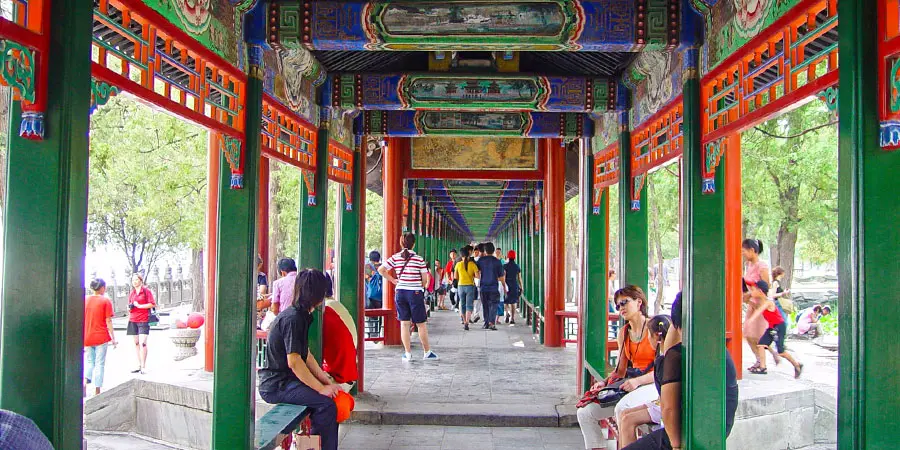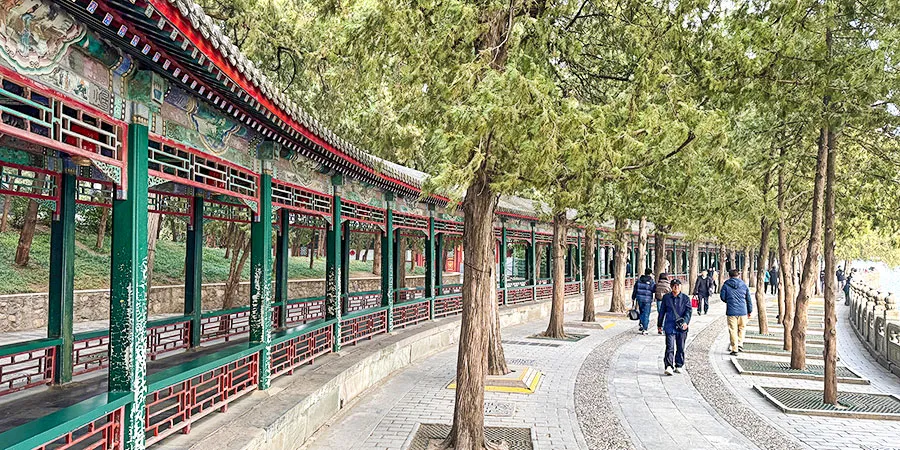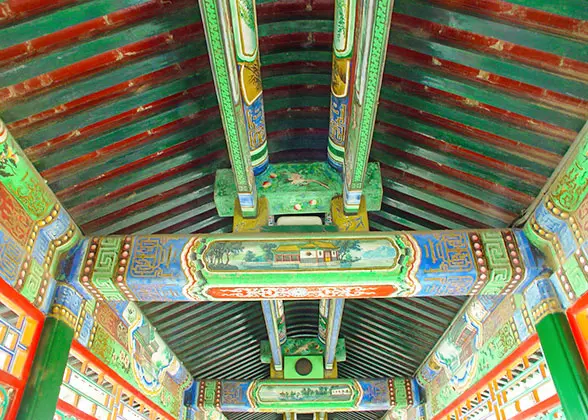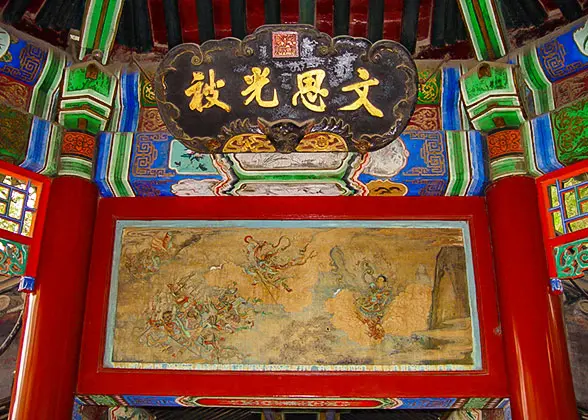Long Gallery (Changlang)
The Long Gallery in the Summer Palace, constructed in 1750 and reconstructed in 1902, stretches between Longevity Hill and Kunming Lake. Now, visitors can stroll along this world's longest gallery to admire its ten thousand striking paintings and exquisite pavilions.
 |
| Long Gallery |
Long Gallery Layout
The Long Gallery, the longest corridor in Chinese classical gardens, was listed in the Guinness World Records as the "World's Longest Gallery" in 1990. It stretches from the Moon Invitation Gate in the east to the Stone Man's Pavilion in the west, with the Gate of Dispelling Clouds located at its center. In total, it comprises 273 rooms (each supported by two pairs of pillars) and spanning 728 meters (796 yards) in length.
Architectural Highlights
Colorful Crossbeam Paintings
The Long Gallery boasts over 14,000 paintings, each framed in a semicircular piece positioned in the middle of crossbeams. Due to this impressive collection, it has earned the title of "the museum of colored paintings".
Crafted using raw mineral colors, they not only add aesthetic value but also serve a practical purpose by protecting the wood structures from the detrimental effects of insects, rain, wind, and sunlight, thereby ensuring their long-lasting durability.
Some of the paintings are in the style of gentle water towns in southern Yangtze River, which rooted from Emperor Qianlong's affection for Hangzhou's West Lake. He even sent painters to sketch there, and they created 546 one-of-a-kind paintings of southern China landscapes, flowers, birds, pavilions, and towers, which were then put up in the gallery.
Beyond West Lake scenes, the gallery showcases over 300 paintings themed around Chinese history and culture. By observing the vividly depicted settings, clothing, and movements depicted, you can guess the story behind each piece. Some are the well-known Chinese tales, such as the myth of "The Monkey King Defeats the White Bone Demon" from "Journey to the West", and the romantic legend of the Cowherd and Weaver Girl's meeting.
What's more, some paintings in the Long Gallery feature traditional Chinese symbols of good luck. For instance, peonies stand for prosperity, while magpies are seen as bringers of happiness.
|
|
Four "Seasonal" Pavilions
Four octagonal pavilions are built along the Long Gallery, named relatively from west to east: Retaining Beauty, Echoing Ripples, Autumn Water, and Tranquil Remoteness.
The pavilions are each designed with a season theme. For instance, the Retaining Beauty Pavilion is planted with early spring flowers such as magnolias and winter jasmines. On the beam on the south side, there is a painting titled "Hundred Children Celebrating Spring", depicting children flying kites and playing diabolos, all immersed in the vibrant spring atmosphere.
In addition, the pavilions are thoughtfully spaced about three hundred steps apart, a perfect distance for a comfortable strolling.
When & Why Built – Long Gallery History
 |
| Long Gallery, Summer Palace |
In 1750, Emperor Qianlong (1711~1799) built the Long Gallery as a rain-shelter corridor for his mother, Empress Dowager Chongqing (1693~1777), who loved strolling in Summer Palace. With the walkway, she could wander leisurely to enjoy theater performances or lakeside views, rain or shine, without needing an umbrella or sedan chair.
Moreover, in the narrow strip between Kunming Lake and Longevity Hill, a straightforward path would have lacked the refined charm of Chinese gardens. Hence, the Long Gallery was constructed, serving as a colorful ribbon that connects numerous scenic spots at the southern foot of Longevity Hill, presenting fresh vistas at every step.
In 1860, the Long Gallery was burned by the Anglo-French forces, leaving only 11 rooms remaining intact. In 1888, it was rebuilt based on original plans and soon became a favorite walkway for Empress Dowager Cixi due to its proximity to her bedroom.
However, in 1900, the Long Gallery suffered damage at the hands of the Eight-Power Allied Forces. The restoration began in 1902, roughly restoring its original architectural layout and style. Further repairs were carried out in the late 20th century to maintain its historical integrity.
It's said that the painted stories in the Long Gallery originates from Emperor Qianlong's mother Empress Dowager Chongqing's love for stories, who often asked maids to narrate various tales as she strolled through the corridor. Over time, the maids ran out of stories and struggled to recall the ones they shared long ago. Desperate for a solution, they came up with the idea: painting stories on the crossbeams of the gallery.
Since the painted figures and tales on the beams became increasingly diverse and vibrant, the maids never worried about running out of stories for Chongqing. As for Chongqing, due to her advancing age and poor eyesight, she remained unaware of the painted tales above her, unknowingly becoming the inspiration behind this unique artistry.
![]() Next: Hall of Dispelling Clouds
Next: Hall of Dispelling Clouds
![]() Related Link: Summer Palace Travel Tips
Related Link: Summer Palace Travel Tips
- Last updated on Sep. 01, 2025 by Jally Zhang -

